► Our list of the cheapest electric cars on sale
► Options range from dinky quadricycles to SUVs
► Prices start from just £7695
Price is one of the main factors preventing motorists from trading in their petrol or diesel car for an electric one, so we’ve put together a list of the cheapest electric cars on sale in 2024. The fact is, the best electric cars cost significantly more than their conventionally powered peers because the materials in their battery packs and electric motors are expensive – and few manufacturers are prepared to make a loss on each EV they sell.
But there are signs this is changing, and 2024 is proving turning point with the introduction of more affordable EVs including the £15,000 Dacia Spring and Citroen’s low-price e-C3 retailing at a whisker under £22k. Recent months have seen several car makers cut the price of their EVs in a bid to make them more attractive, with manufacturers under greater pressure to meet electric car sales targets that came into force in 2024.
The cheapest electric cars on this list might not have the fancy interior technology and safety equipment you’ll find in something like a Tesla Model 3, and they might not have the glamour of the best electric luxury cars, but you can’t argue with the value.
The best cheap electric cars at a glance:
Below, we’ve rounded up the cheapest electric cars on sale in the UK today. Our list includes tiny electric quadricycles, family-sized electric hatchbacks and compact electric SUVs. This list has changed in recent months due to the introduction of new models and a price cut to existing EVs. We’ve also included links to our dedicated review for each electric car if you need some extra information on how they drive. Scroll down for some inspiration.
The cheapest electric vehicles (EVs) to buy in 2024
Citroen Ami – from £7695
Best for: City-only driving
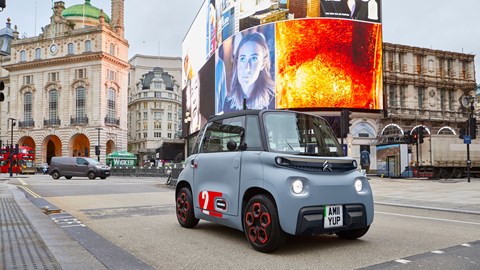
Pros: Minuscule dimensions, great fun, no car will get more attention
Cons: Bad ride, you’ve seen the video of one being rolled in Monaco, right?
Citroen had one goal in mind when it was designing the Ami – to build the ultimate small electric car. And it bashed the nail on the head with a 20lb sledgehammer. The Ami is perfectly suited to city life. It’s small, so it can fit down narrow alleys. Its cabin is surrounded by glass, so you can spot kamikaze moped riders long before you could in a conventional car. Plus, because it’s electric, you don’t need to pay Sadiq Khan a single penny to drive into the centre of London, at least for now.
The only fault with the Ami is that it only works in the city. It has a maximum range of 46 miles and a top speed of just 28mph. That’s more than enough for zipping around Knightsbridge but nowhere enough to venture out of the city and onto an A-road. It’s achingly slow. Stay within the confines of town, and you’ll be king of all you survey, though. The Ami is more than nimble enough to carve up Civics and Golfs on roundabouts, while its 8bhp motor is sprightly enough to surprise them at the lights.
Read our full Citroen Ami review
Dacia Spring – from £14,995
Best for: The cheapest ‘proper’ electric car you can buy
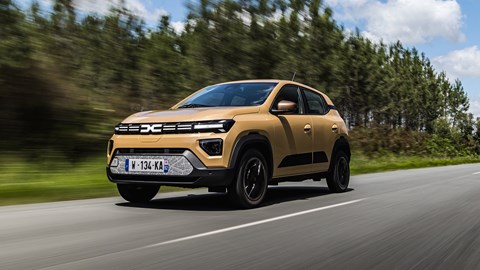
Pros: Cheaper than an equivalent petrol city car, impressive interior, decent equipment
Cons: Questionable safety, small range limits usability
Brits have previously been deprived of the value-packed Dacia Spring, one of the most popular electric cars across Europe. But that changes later in 2024 when a new version of the Spring lands in the UK. A compact city that’s quite a lot smaller than the Sandero, the Spring grabs the headlines with a starting price of just £14,995, making it by far the cheapest proper electric car available. Finance deals have been confirmed from £169 a month with a £2325 deposit on a four-year PCP lease deal, with interest at 3.9% APR.
The new Spring is powered by a fairly small 44bhp motor as standard, with a dizzying 64bhp available from higher-spec versions. A 26.8kWh battery allows for a claimed range of up to 140 miles, giving scope for some out-of-town trips but you wouldn’t want to go too far as it’s not very quick to charge with a maximum 30kW DC rapid charging rate. Standard kit includes a digital instrument cluster, cruise control and rear parking sensors as well. The Spring is available to pre-order now and the first right-hand drive UK cars are expected by October.
To find out more read our full Dacia Spring review
Citroen e-C3 – from £21,990
Best for: Cheap and the promise of comfort
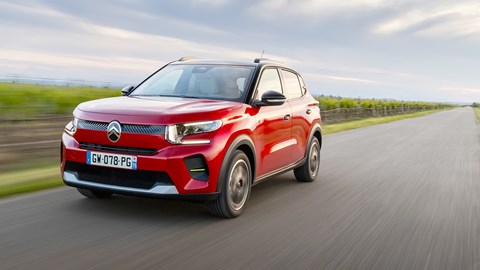
Pros: Good range, great price, very comfortable
Cons: Slow steering, boot is an awkward shape
Citroen already has a fairly expansive line-up of electric models, but it’s hunting the cheaper end of the market with its new e-C3, which arrives as part of a fourth generation of Citroen’s popular supermini. Getting a chunkier look to appeal to SUV-loving buyers, the e-C3 comes with the firm’s trademark comfy suspension and seats, and it’ll likely prove a great daily driver.
Orders are yet to open but it’s expected to arrive in the UK before the close of 2024, and makes for a great option with its 199-mile range and quick 100kW DC charging. It drives well, is surprisingly spacious and comes with plenty of kit as standard, with an attractive £21,990 starting price considering it’s a much more rounded car than the Spring.
Find out more and read the Citroen e-C3 review
Fiat 500 Electric – from £28,195
Best for: The fashion-conscious
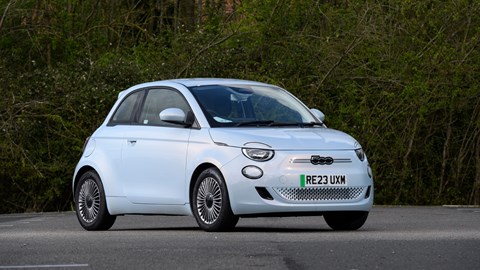
Pros: Looks great, drives well, recent price cut
Cons: Range isn’t amazing with standard trim, isn’t particularly practical
We like the Fiat 500 Electric. It’s by no means the fastest, most practical or longest-legged electric hatchback on sale – but it does have the biggest character. Just like its petrol-powered predecessor, it’s ideally suited to the city. However, it’s sophisticated enough to allow you to tackle faster roads. Providing you keep a mental note of all the nearby charging stations, that is. The entry-level model only has a tiny 24kWh battery that offers a maximum official range of 118 miles.
The 500e has always been quite expensive by city car standards, but Fiat has recently slashed its price to improve sales. It now starts from £21,995 for the entry-level 24kWh version, with a 118-mile range. We’d recommend paying the £24,995 for the larger 42kWh battery, which manages a claimed 199 miles between charges. It’s good to drive and gets lots of tech for such a small car car, but isn’t very practical so is best treated as a two-seater.
To find out more read our full Fiat 500 Electric review
BYD Dolphin – from £26,140
Best for: Those wanting something different
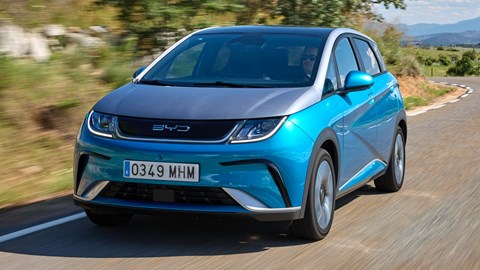
Pros: Fantastic value for money, interesting interior, comfortable ride
Cons: MG4 is better to drive for similar money, intrusive safety tech
Chinese brand BYD gives you a lot of car for the money with its amusingly named Dolphin, which is far larger than the other cars on this so far. It has enough space inside for four adults, plus it has a 345-litre boot. The cheapest £26,140 model features a 45kWh battery allowing a claimed maximum range of 211 miles, but a larger 60kWh unit increases this to 265 miles.
It even drives quite well. Sure, it isn’t as polished as a European electric hatchback, such as a Cupra Born, but it still offers plenty of grip and manageable levels of body roll. And, if you opt for the more expensive 60kWh 201bhp version, you’ll have a car that can dash from 0–62mph in 6.7 seconds. The interior is quirky, too – the infotainment screen is mounted on a motor and can spin through 90 degrees to be either portrait or landscape.
To find out more read our full BYD Dolphin review
Vauxhall Corsa Electric – from £26,895
Best for: Familiarity
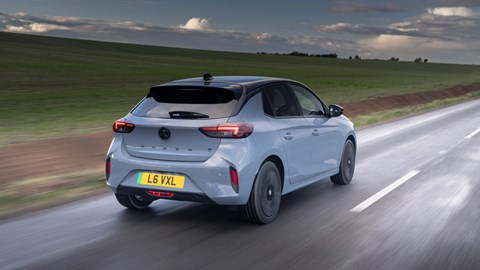
Pros: Huge price cut, excellent spec, decent range
Cons: Could be more spacious, nothing special to drive
The Vauxhall Corsa continues to be one of the UK’s most popular cars, with the addition of an electric version boosting its success in recent years. That said, the EV model has always been scuppered by its expensive price.
But Vauxhall has addressed the Corsa’s high price with the addition of a new value-packed ‘Yes Edition’, that drops the Corsa EV’s starting price by a significant £5,550. You still get the same 134bhp electric motor and 50kWh battery enabling a claimed 221 miles from a charge too. And it’s not like Vauxhall has ripped out all the equipment either, as you still get LED headlights, keyless entry and a 10-inch touchscreen to name just a few highlights.
To find out more read our full Vauxhall Corsa Electric review
MG 4 EV – from £26,995
Best for: Everything, really
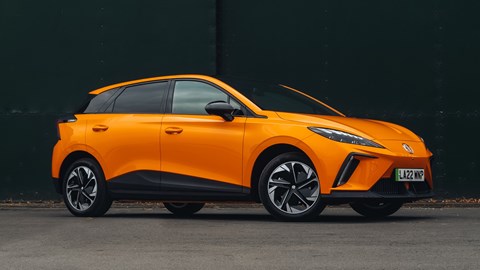
Pros: Great to drive, long range, plenty of tech
Cons: Interior feels a bit cheap, iffy reliability
Like the Dolphin, the MG 4 EV is another Chinese electric hatchback. But, where the BYD focuses on comfort, the MG majors on driver engagement. It’s arguably the best-driving car in its class, running rings around the likes of the Volkswagen ID.3 while simultaneously shaving thousands off its asking price. When you’re pushing really hard, the MG 4’s rear-driven platform will even allow you to slide the back end out, just like a sports car. It’s a riot.
Happily, the MG 4 is more than just a one-trick pony. It’s practical, too. There’s enough space in the back for two adults, and it has a reasonably sized 363-litre boot. Granted, the ID. 3’s rear seats are more comfortable for adults, and its boot is slightly larger at 385 litres, but you should expect to make a few sacrifices when the price gulf between the two cars is more than £8,000. The beauty of the MG 4 is that you make fewer sacrifices than you’d expect.
To find out more read our full MG 4 EV review
Mazda MX-30 – from £27,995
Best for: Those wanting a quirky electric SUV that priorities fashion over functionality
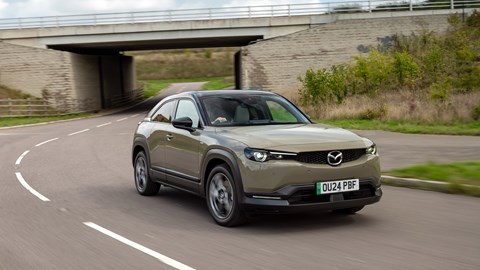
Pros: Cool design, high-quality interior, good to drive
Cons: Poor electric range, not very practical
The MX-30 trades on its styling, which is just as well because it’s absolutely hopeless at covering distance. That’s because it has a tiny 35.5kWh battery pack, whereas most of its rivals have batteries of 50kWh or more. The result? A maximum WLTP range of 124 miles and a best-case real-world range of only 100 miles. Ouch.
Still, you should at least have fun on your distance-restricted outings because, like most Mazdas, the MX-30 is fun to drive. It is also loaded with interesting design features, such as reverse-opening rear doors, wooden trim on the centre console and soft door card trims made from recycled plastic bottles. While previously quite tough to recommend, Mazda has recently slashed prices by £3,000, making it seem a whole lot more appealing at £27,995.
Read our Mazda MX-30 review
Nissan Leaf – from £28,495
Best for: Affordable and spacious electric motoring
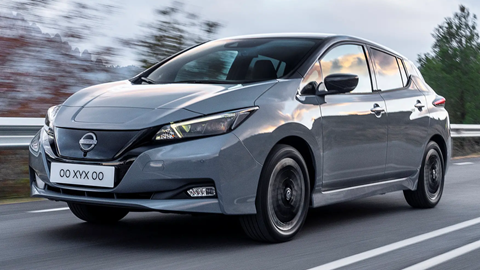
Pros: Lots of space, easy to use, relaxing to drive
Cons: Soon to be discontinued, outdated charging tech
What the Nissan Leaf lacks in range and fast-charging tech, it claws back with its affordable price tag. The most basic cars cost from £28,495 – and even the flagship Tekna variant (with its Bose audio system and clever driver assistance kit) will give you back a fiver’s change from £32,000.
These days, you can only have the Leaf with a 39kWh battery, giving you a maximum range of 168 miles. Its electric motor serves up 148bhp, but the Leaf never encourages you to drive spiritedly. Its suspension is set up for comfort, and its steering is rather light and vague, which means it’s at its happiest bumbling along at 10mph under the speed limit. Nissan has recently stopped production of the Leaf as it gears up to launch its next generation of EVs, so vehicles are available from stock only.
Peugeot e-208 – £28,600
Best for: Stylish all-rounder
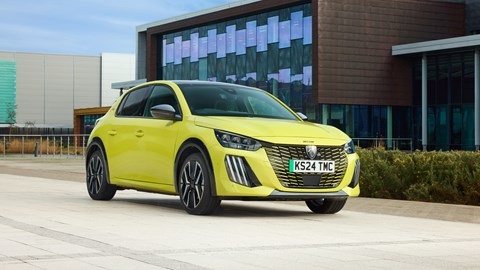
Pros: Stylish design, Easy to drive, lots of equipment
Cons: Awkward driving position, not all that spacious
The Peugeot e-208 has always been a credible small electric car, but with one caveat: its high price. The French firm seems to be acknowledging this now, with a recent price cut meaning this supermini now comes in at £28,600, and reduces the gap between EVs and petrol models.
Though not everyone will get on with Peugeot’s trademark awkward driving position, the e-208 is otherwise very easy to drive and live with, gets a decent range of 224 miles (claimed) and is arguably the best-looking supermini you can buy too. Standard equipment also includes climate control, LED lights and a 10-inch touchscreen too.
To find out more read our full Peugeot e-208 review
What is the cheapest electric car to buy today?
That depends on your definition of ‘car.’ The cheapest fully enclosed, road-legal, four-wheeled vehicle you can buy is the Citroen Ami, priced from just £7695. However, it isn’t legally recognised as a car – it’s a pure-electric quadricycle. The cheapest proper electric car you can buy is the Dacia Spring, which costs from just £14,995.
Are electric cars getting cheaper?
Gradually, with much of that change being driven by Chinese manufacturers. Falling R&D costs, economies of scale, and the presence of smaller, less upmarket electric cars to sit alongside the big electric SUVs and saloons that kickstarted the whole shift towards electrification mean the market’s becoming ever more friendly to those on a budget.
With manufacturers increasingly under pressure to shift more EVs to meet mandatory sales targets, we’re seeing more firms cut the prices of their existing models to boost demand. Cupra, Honda, Mazda and Vauxhall have all slashed the prices of their electric cars in recent months. This will trend will only likely continue later in 2024.
Is it worth buying a used electric car?
Buying any used car always means you’ll take on a certain amount of risk, but EVs are a different kettle of fish. The positives? There are far fewer parts to go wrong, and most are loaded with technology. But the value of an EV hinges on the condition of its battery pack – and if the cells have been thrashed by the car’s previous owner, you could end up with a lemon that won’t do half of its claimed range. On newer EVs, you shouldn’t need to worry.
There are some significant savings on nearly-new cars to be had if you’re not bothered about being the first person to have their name on the V5. We’ve compiled a guide to buying a used EV that includes a list of the best cars you might want to consider. Follow the link above to learn more.
Are there any cheap EVs worth waiting for?
In 2024 we’ll see the arrival of two far more affordable EVs mentioned in this article. The first is the new Dacia Spring, a car that’s been on sale in other European countries for several years, but will now come to the UK for the first time, with a starting price of just £14,995. Citroen’s e-C3 will be a larger and more substantial offering on top of that, and be available for less than £23,000, again undercutting the opposition.
Are electric cars cheap to charge?
That depends on where you charge your electric car. Plug in at a motorway rapid charger at peak times, and you could end up spending more on electricity than you would for a tank of fuel in an equivalent petrol car. However, you could save hundreds of pounds if you charge up at home using a wallbox charger and an intelligent charge scheduler that can reap the benefits of an off-peak electricity tariff.